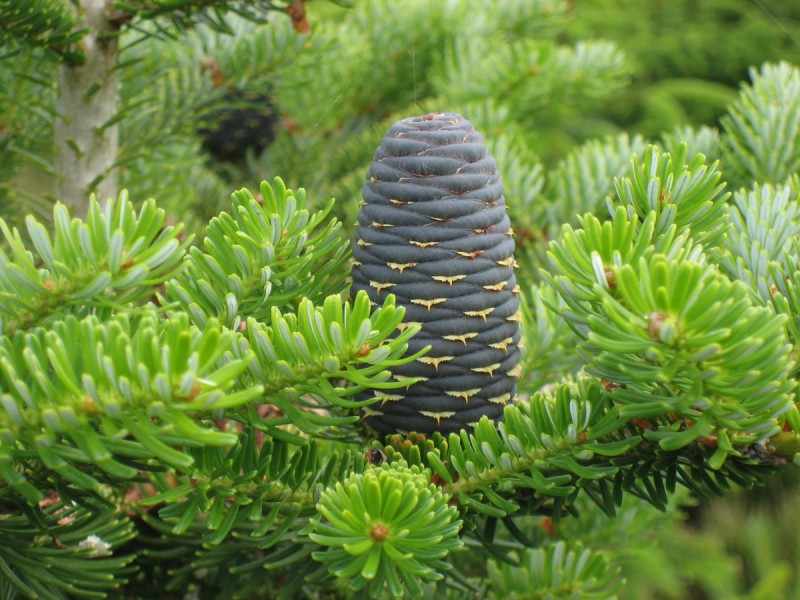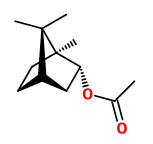Dies ist eine alte Version des Dokuments!
Abies koreana E. H. Wilson - Pinaceae - 구상나무 gusang namu (Kor.), Korean fir, Korea-Tanne
Evergreen coniferous tree, up to 18m tall, native to Korea, cultivated as ornamental.
There are several cultivars, e.g. 'Silberlocke' introduced in Germany in 1986 by Gunter Horstmann.
http://www.missouribotanicalgarden.org/PlantFinder/PlantFinderDetails.aspx?taxonid=241721
https://de.wikipedia.org/wiki/Korea-Tanne
Main components of the essential oil from the needles of A.koreana were limonene (23.4%), bornyl acetate (17.8%), α-pinene (11.1%), camphene (10.2%), and β-himachalene (4.1%). The essential oil exhibited high antimicrobial activity against the tested organisms Escherichia coli, Staphylococcus epidermidis and Candida albicans.
[Chemical and antimicrobial properties of essential oils from three coniferous trees Abies koreana, Cryptomeria japonica, and Torreya nucifera., Oh, H.J., Ahn, H.M., So, K.H., Kim, S.S., Yun, P.Y., Jeon, G.L., Riu, K.Z., Journal of Applied Biological Chemistry, 50(3), 164-169, 2007] http://ocean.kisti.re.kr/downfile/volume/ksabc/E1OOBF/2007/v50n3/E1OOBF_2007_v50n3_164.pdf
Main compounds of the essential oil from the needles of A.koreana (hydrodistillation, 0.9%) were borneol (27.9%), α-pinene (23.2%), β-pinene (5.8%), terpinene-4-ol (3.8%), bornyl acetate (3.4%) and α-terpineol (3.1%). The oil exhibited broad spectrum antibacterial activity against tested organisms, including methicillin-resistant Staphylococcus aureus.
[Chemical composition and antibacterial activities of the essential oil from Abies koreana., Jeong, S.I., Lim, J.P., Jeon, H., Phytotherapy Research, 21(12), 1246-1250, 2007]
„Abies koreana essential oil (AKE) possessed anti-inflammatory and antibacterial activities against skin pathogens. In this study, AKE showed excellent antibacterial activities against drug-susceptible and -resistant Propionibacterium acnes and Staphylococcus epidermidis, which are acne-causing bacteria. In addition, AKE reduced the LPS-induced secretion of tumor necrosis factor-α (TNF-α), interleukin-1β (IL-1β), IL-6, NO and PGE2 in RAW 264.7 cells, indicating that it has anti-inflammatory effects.“
[Abies koreana essential oil inhibits drug-resistant skin pathogen growth and LPS-induced inflammatory effects of murine macrophage., Yoon, W.J., Kim, S.S., Oh, T.H., Lee, N.H., Hyun, C.G., Lipids, 44(5), 471-476, 2009]
Major component of the fresh resinous scenting essential oil of the seeds (hydrodistilled, 3.8-8.5%) was (-)-limonene (41-72%, 95%ee).
[Composition of essential oils from seeds of Abies koreana., Wajs-Bonikowska, A., Olejnik, K., Bonikowski, R., Banaszczak, P., Natural product communications, 8(2), 227-230, 2013]
Main compounds of the essential oil from the seeds of A.koreana (hydrodistillation, 3.8%) were (-)-limonene (53.7%, 96%ee), bornyl acetate (12.1%), α-pinene (12.1%), camphene (11.2%), β-pinene (2.0%), and borneol (1.1%). Major components of the essential oil from the cones (0.5%) were α-pinene (56.8%), (-)-limonene (13.0%, 96%ee), β-pinene (11.2%), bornyl acetate (2.9%), and camphene (2.4%).
[Chemical Composition and Biological Activity of Abies alba and A. koreana Seed and Cone Essential Oils and Characterization of Their Seed Hydrolates., Wajs‐Bonikowska, A., Sienkiewicz, M., Stobiecka, A., Maciąg, A., Szoka, Ł., Karna, E., Chemistry & biodiversity, 12(3), 407-418, 2015]

Abies koreana cone Wikimedia Commons, Author: MPF
CC BY-SA 3.0



